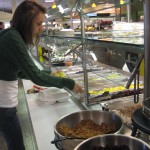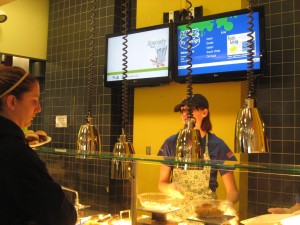People may think of chickens, pigs or cows when thinking of farm animals. But here in Ohio, fish are increasing the farm animal choice.
Over the last decade there has been an annual increase in the number of fish farms in Ohio. In 1998 there were 33 farms in Ohio. Recently, the Census of Aquaculture predicted over 200 fish farms in Ohio. And the opportunities only keep growing.
With consumers looking for a healthier diet, more people are turning to fish and no longer looking at poultry as their only choice of lean protein. The good fish oils are important nutritionally. The more people hear about this, the more fish they consume.
The U.S. Economic Research Service said, on average, Americans are eating four pounds more fish per year now than they did in the 1970s. Global fish consumption has risen to a record of almost 17 kilograms a person.
The rising global demand for fish and concerns over depleting ocean stocks have increased the demand for farmed fish. According to reports by the FAO., aquaculture now makes up 46 percent of the world’s food-fish supply, up from 43 percent in 2006.
View Fish Farms in Ohio in a larger map
As the numbers continue to increase, even more farmers are interested in starting a fish farm of their own. Before starting a fish farm, one must be aware of the fact that they will have to spend a pretty penny and have a lot of patience. As a co-owner of Remlinger Farm in Kalida, Ohio, Mark Remlinger is familiar with the process of starting a fish farm.
“It is very expensive and risky form of agriculture. Aquaculture involves capital investment, daily labor, and management and above all, risk,” Remlinger said.

Bait fish at Bowling Green's Satellite Aquaculture Center. Photo By: Saisha Gailliard
Many times, people interested in aquaculture are looking for an enterprise with low initial investment. “Aquaculture can be a very capital intensive business. People that just get into the business for the money usually don’t like it,” explained Remlinger.
To help Ohio farmers learn more about aquaculture, Ohio State University has established a research program.
“We deal with the very specific problems that people within the industry have that they can not answer for themselves,” said Laura Tiu, an aquaculture specialist at Ohio Center for Aquaculture Research and Development (OCARD).
Currently, some of the top research projects involve addressing issues with raising baitfish, bluegill and yellow perch. Another program has produced two improved lines of perch. OCARD expects for the program aims to increase aquaculture production and efficiency of perch and the bluegill by 30 to 50 percent by developing genetically improved brood stocks.
Such information can be very helpful for someone like David Smith, president of Freshwater Farms of Ohio, in Urbana, Ohio.
“Were constantly hearing information about new research. Even though we’ve been around since the 80 s, we’re always looking for ways on how to improve,” said Smith.
From the very beginning, Smith and his family knew there was potential in the aquaculture industry.
“A lot of people look to coastal areas to raise fish, but I decided that the best way to expand was in freshwater farming. And throughout the years, many people have started to do the same thing,” said Smith, who has a doctorate in fish nutrition.
Not only looking at the success of his business, but also the growth of aquaculture in Ohio, Smith is convinced things will only continue to improve for aquaculture.
And yet, many people are concerned that there maybe too much growth occurring within aquaculture.
The Growth faces Limits
As aquaculture is constantly growing, reports state there is a downfall to having a high demand for fish. In February of this year,The International Herald Tribune reported on studies by the U.N. Food and Agriculture Organization (FAO) finding that aquaculture cannot continue growing indefinitely at its current pace. According to reports from the FAO. there has been an annual increase of 6.6 percent of production volume from 1970 to 2008. And over this period, the global per capita supply of farm raised fish rose from 0.7 kilograms to 7.8 kilograms. In response to this, Kevern Cochrane, director of the FAO’s resources use and conservation division, released a statement explaining that the U.S. is “going to run into constraints, in terms of space availability, water availability- particularly fresh water- and also environmental aspects and supply of food.”
To keep up with the high global demand for fish, production will have to double. Aquaculture has the potential to fulfill such high demand. With aquaculture, fish can be raised in tanks, ponds, oceans, lakes or even rivers. More technology is making it more convenient for farmers to raise fish both indoors and outdoors. Buying equipment to raise fish indoors, such as tanks, can be expensive, but it allows farmers to raise fish throughout the entire year. Usually farmers who only have an outdoor pond are limited to raising fish in the early spring to late fall season.
Environmental Concerns
With aquaculture on the rise, environmentalists are concerned about the effects of fish farming. According to the Environmental Defense Fund, some of these concerns include the pollution of local waterways with waste and antibiotics and the transfer of parasites from farmed to wild fish. And despite the high demand for fish, environmentalists are still concerned about the effects that aquaculture has on the environment.
The fish feed has become a major concern. Fish farms use feed made from fish oil or fishmeal. Many times small fish is caught at sea and fed to bigger fish raised on farms. There is concern that fish farming is depleting the oceans level of wild fish instead of easing the problem.
In consideration of this, more farmers in Ohio are using more grain-based diets to feed their farmed raised fish. Doing so is not only beneficial to the wild fish population but is also a money saver for farmers. Globally there is a high demand for fish feed. Due to this demand, the price of fish feed has tripled in the last 10 years. A lot more farmers are learning how to use the fish oil and fishmeal more efficiently.
Dave Smith of Ohio’s Freshwater Farms feeds more grain-based diets to his fish as the high price of diesel has made catching wild fish more difficult.
“It takes a lot of energy to go out and catch wild fish and wild shrimp. It takes 50 calories of fuel energy to catch one calorie of shrimp and takes a tenth of this to raise fish on a farm,” explained Smith.
The Ohio Department of Natural Resources requires permits for transportation of fish and other marine species. This protects the state’s natural resources. Without such regulations from the ODNR a non-native species could be released from a fish farm and could compete with a native species and threaten its survival. The Ohio Department of Aquaculture works closely with the ODNR to prevent the spread of a fish disease, known as viral hemorrhagic septicemia, or VHS, in both farmed and wild species. Constant monitoring is necessary to prevent the spread of the disease.

A recirculating water system at BG's aquaculture center. Photo By: Saisha Gailliard
Recirculating water systems have also been another way for fish farming to practice sustainability. Shawn McWhorter, research associate and aquaculture specialist for OCARD, uses recirculating systems for the fish at Bowling Green’s aquaculture center.
“With recirculating systems, we’re adding in what we need and we’re taking out what we don’t,” McWhorter explained.
The biggest benefit of the recirculating system is it’s smaller water footprint. The closed-loop production systems continuously filter and recycle water.

Shawn McWhorter feeding fish placed in a recirculating water system. Photo By: Saisha Gailliard
“With the systems we’re using less water and able to control waste streams much better than we can with a pond, so it’s more environmentally friendly,” said McWhorter.













